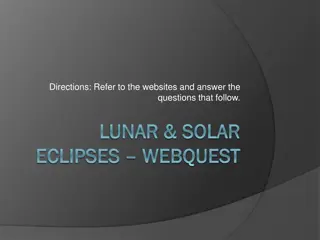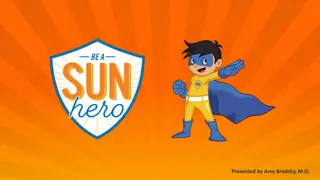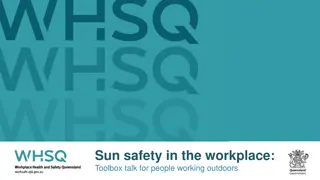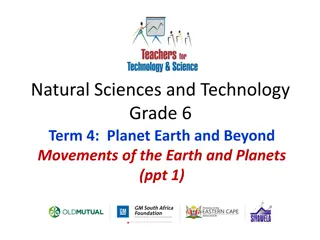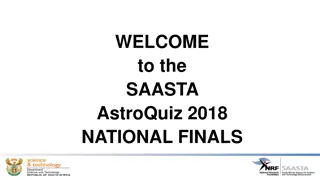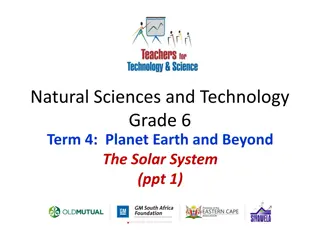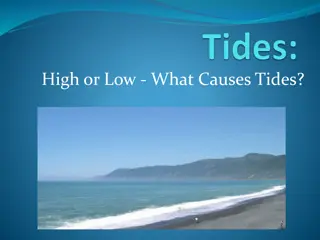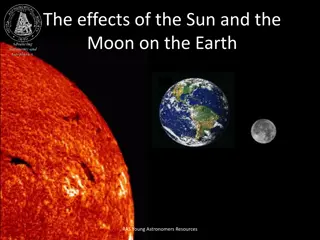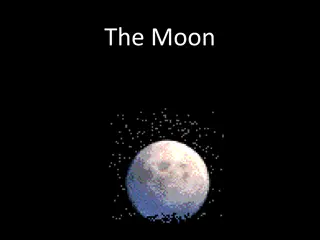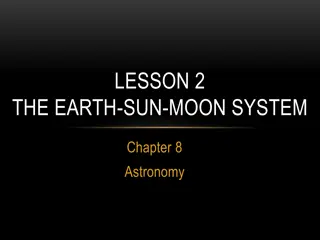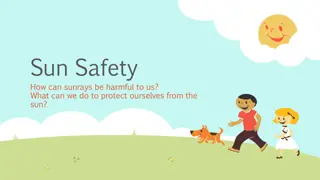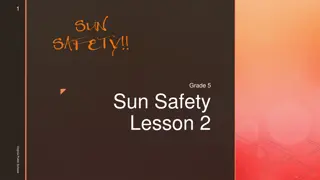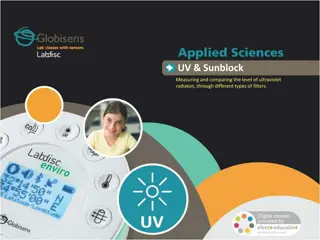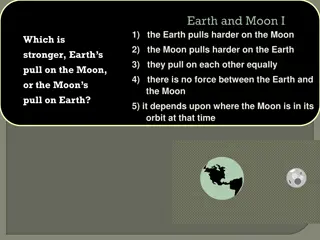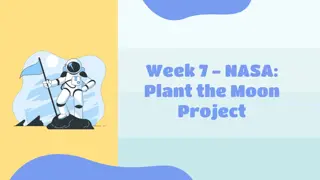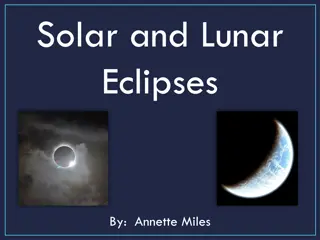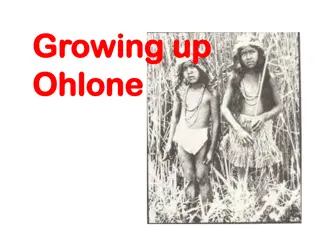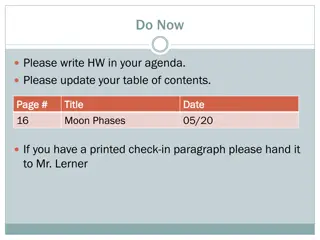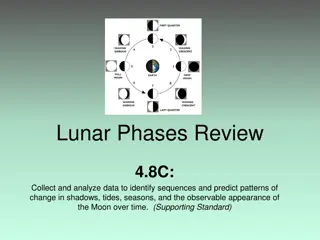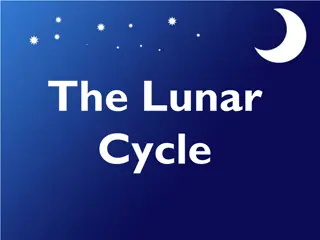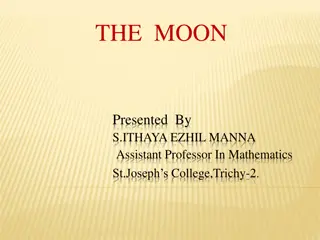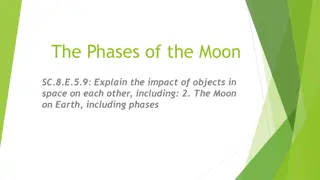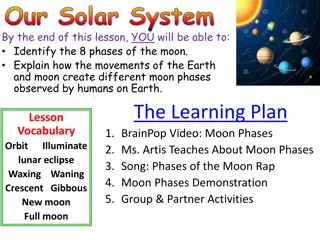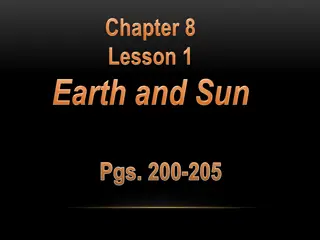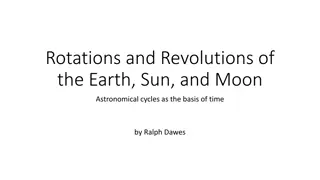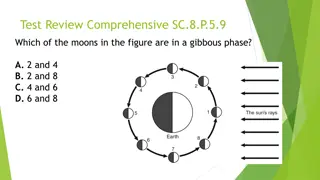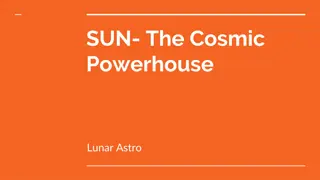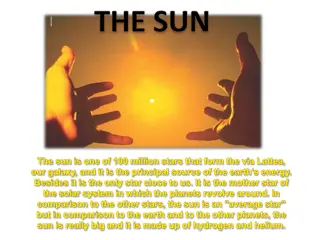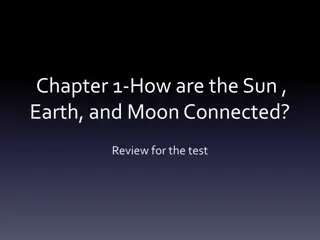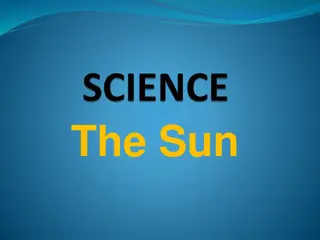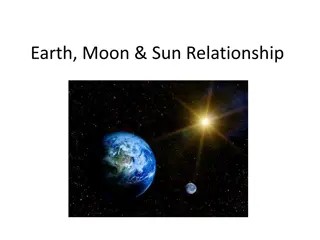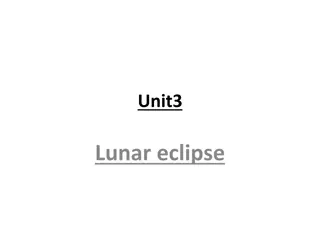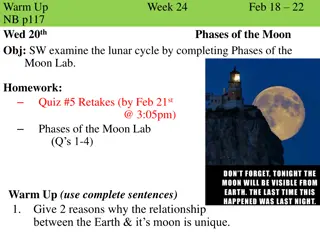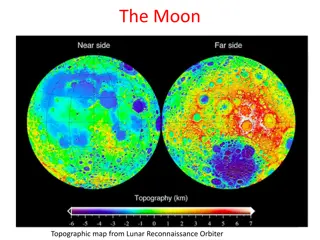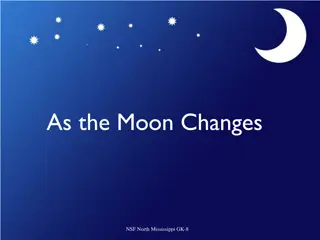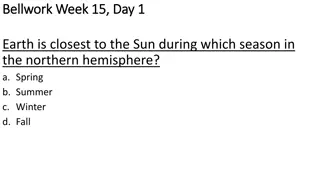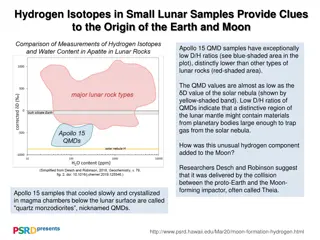Understanding Eclipses: The Celestial Dance Between the Sun, Moon, and Earth
Eclipses are fascinating astronomical events where the Moon comes between the Sun and Earth, causing either a solar eclipse or lunar eclipse. This summary delves into the different types of eclipses, such as total and partial solar eclipses, the Moon's elliptical orbit, and the intricate movements t
4 views • 25 slides
Exploring Moon Phases and Lunar Basics
Delve into the fascinating world of moon phases and lunar phenomena. Learn about the different phases of the moon, why we see the moon, rotation, revolution, waxing, waning, and more.
8 views • 32 slides
Understanding Lunar and Solar Eclipses: A Comprehensive Webquest
Delve into the intricacies of lunar and solar eclipses by exploring informative websites. Learn about lunar eclipse phases, types, and causes, sketch the Earth-Moon-Sun alignment, discover the reasons for eclipse frequency, and differentiate between the three lunar eclipse kinds. Unravel the mystery
0 views • 12 slides
Promoting Sun-Safety Education for Children
Sun damage in childhood is a key risk factor for skin cancer later in life. Initiatives like the SUNucate model legislation aim to ensure access to sunscreen in schools. The Sun Hero Program equips healthcare professionals to educate children on sun-safe behaviors through fun materials and sun-prote
0 views • 10 slides
Sun Safety in the Workplace: Toolbox Talk for Outdoor Workers
Understand the importance of sun safety in the workplace, especially for individuals working outdoors. Learn about the risks of UV radiation exposure, the significance of the UV Index, effects of ultraviolet radiation (UVR) from the sun, and practical sun protection measures. Follow guidelines to st
0 views • 11 slides
Understanding Movements of Earth and Planets in Grade 6 Natural Sciences and Technology
Explore the concepts of rotation and revolution in the movements of Earth and planets. Learn about Earth's rotation causing day and night, its revolution around the Sun leading to seasons, and the interactions between Earth, Moon, and Sun in Grade 6 Natural Sciences and Technology.
1 views • 9 slides
SAASTA AstroQuiz 2018 National Finals - Lunar Eclipse Questions
The SAASTA AstroQuiz 2018 National Finals feature a series of questions related to lunar eclipses, moon characteristics, and celestial bodies. Participants must answer questions about the longest lunar eclipse of the 21st century, the color of the moon during an eclipse, and the relationship between
0 views • 54 slides
Exploring the Solar System: The Sun and Beyond
Delve into the fascinating world of our Solar System, focusing on the central star, the Sun. Learn about the different celestial bodies and their composition, with a special emphasis on Earth as a planet. Discover the Sun's characteristics, including its size, temperature, and structure. Explore the
0 views • 7 slides
Understanding the Causes of Tides and Their Effects on Earth
Tides are a result of the gravitational interactions between Earth, the Moon, and the Sun. The Moon's gravity creates tidal bulges on Earth's surface, leading to the daily rise and fall of water levels known as tides. These phenomena have a significant impact on ocean coastlines and the overall wate
0 views • 16 slides
Exploring Sun, Moon, and Earth: Resources for Young Astronomers
Discover the fascinating effects of the Sun and Moon on Earth, learn about the Sun-Earth-Moon system, explore the scale of these celestial bodies, understand the phases of the Moon, observe tides, uncover the reasons behind the four seasons, and watch educational videos on lunar phases and tides. Di
0 views • 9 slides
Understanding Earth's Seasons and Moon Phases
Explore the primary causes of Earth's seasons, the positioning of winter in the Northern Hemisphere, and the eight phases of the lunar cycle. Learn about the characteristics of the moon in its waxing and waning phases, the time it takes to transition between moon phases, and the role of the sun in t
0 views • 24 slides
Exploring the Wonders of the Moon
Discover interesting facts about the Moon, including its distance from Earth, rotation, surface features like craters, and its impact on tides. Learn why the Moon's appearance changes, explore moon phases and tides through engaging animations, and understand the gravitational influence that causes t
0 views • 19 slides
Exploring the Earth-Moon System in Astronomy
Investigate the fascinating interplay between Earth, the Moon, and the Sun including lunar phases, eclipses, tides, and more. Discover the Moon's unique characteristics and lunar landscape features captured by Apollo missions.
0 views • 37 slides
Importance of Sun Safety: Protecting Yourself from Harmful Sunrays
Sunrays can be harmful due to UV rays causing sunburn, skin aging, and increasing the risk of skin cancer. Playing outside is beneficial, but protection is essential with sunscreen, sunglasses, hats, and seeking shade. All sun damage is preventable by following sun safety tips to reduce risks of UV
0 views • 6 slides
Sun Safety Lesson for Grade 5 in Virginia Public Schools
This lesson covers the importance of sun safety for Grade 5 students in Virginia Public Schools. It includes learning objectives about skin protection, risks of sun exposure, and practical strategies to stay safe in the sun. The lesson also includes a review section and a role-playing activity to pr
0 views • 5 slides
Understanding UV Radiation and Sun Protection
The experiment focuses on measuring and comparing levels of ultraviolet radiation using different filters to understand the effects of sun exposure. It delves into the physical definition of sun radiation, positive and negative impacts on Earth, methods of prevention, and the role of skin products a
0 views • 19 slides
Understanding Gravitational Forces Between Earth and Moon
Exploring the gravitational forces between Earth and the Moon, we learn that they pull on each other equally due to Newton's 3rd Law. The force depends on the distance squared, meaning doubling the distance reduces the force by a factor of 4. When in an airplane at high altitude, your weight is less
1 views • 21 slides
NASA Plant the Moon Project: Engaging Space-themed Activities for Children
Explore the NASA-sponsored Plant the Moon challenge that encourages children to learn about lunar colonization through planting activities. This initiative aims to foster an understanding of sustaining life on the moon by planting seeds and overcoming challenges for successful growth, offering lesso
0 views • 30 slides
Understanding Solar and Lunar Eclipses
Solar and lunar eclipses are celestial phenomena where shadows are cast by one celestial body upon another. A solar eclipse occurs when the Moon blocks the view of the Sun during the new moon phase, while a lunar eclipse happens when the Earth's shadow falls on the Moon. This article explains the di
0 views • 38 slides
Sun and Moon: A Tale of Ohlone Children
Sun and Moon, children of the Ohlone tribe, enjoyed their days near the river at Tuibun. They played, learned skills, and explored nature throughout the seasons. As autumn arrived, changes in nature signaled the shift to colder days. The importance of plants for food and resources was emphasized. Th
0 views • 25 slides
Exploring Earth's Moon Phases and Motion
Delve into the intriguing phenomena of Earth's Moon, examining its phases, formation, reflective properties, and orbital motion around our planet. Discover why we always see one face of the Moon, how its appearance changes in the sky, and the captivating lunar cycle that governs its illuminated stag
0 views • 14 slides
Explore Lunar Phases and Patterns in Astronomical Observations
Dive into the study of lunar phases, shadows, tides, seasons, and the moon's observable appearance over time. Test your knowledge with questions about moon phases, identify the sequence of moon phases, understand the causes behind moon phases, and determine the correct order of moon phases. Enhance
0 views • 13 slides
Understanding the Phases of the Moon and the Lunar Cycle
The moon goes through eight distinct phases during its 27-day Lunar Cycle, each characterized by its illumination level as seen from Earth. From the invisible New Moon to the fully illuminated Full Moon, learn about each phase and how they occur as the moon orbits the Earth.
0 views • 15 slides
The Moon: A Celestial Neighbor
The moon, Earth's closest celestial neighbor, orbits the Earth following Kepler's laws. With a distance of about 240,000 miles and a linear diameter of 2163 miles, the moon's mass is about 1/81 times that of Earth. Learn about the lunar orbit, nodes, and its relationship with synodic and sidereal mo
0 views • 11 slides
Understanding the Phases of the Moon and Their Impact on Earth
This content delves into the phases of the moon and its influence on Earth, explaining the causes of each phase and detailing the interactions between the Moon, Earth, and Sun. Resources such as images, videos, and a game plan are provided to enhance understanding, along with a question related to i
0 views • 26 slides
Exploring the Phases of the Moon in Our Solar System
Uncover the secrets of the moon's phases in our solar system with engaging lessons, activities, and essential questions. Understand how the Earth and moon's movements create different moon phases observed from Earth, and discover the beauty and science behind lunar eclipses. Dive into the 8 phases o
0 views • 22 slides
Understanding Day, Night, and Seasons on Earth
Earth's rotation on its axis causes day and night, with the Sun appearing to rise in the east and set in the west. The movement of stars, Moon, and planets across the sky each night is due to Earth's rotation as shadows change in length throughout the day. Seasons result from Earth's revolution arou
0 views • 20 slides
The Earth, Sun, and Moon: Rotations and Revolutions Explained
Discover the complexities of time measurement based on astronomical cycles involving the Earth, Sun, and Moon. Learn how the varying lengths of sidereal and solar days relate to the Earth's rotational speed, its elliptical path around the Sun, and the concept of leap years to adjust our calendar sys
0 views • 23 slides
Moon Phases, Observations, and Earth's Tilt Study
Explore questions on moon phases, lunar observations, and Earth's tilt in this comprehensive science review. Answer inquiries on lunar phases, moon appearances, and the Earth's position. Engage in activities to predict moon phases, identify specific moon appearances, and comprehend the relationship
0 views • 19 slides
Unveiling the Cosmic Power of the Sun in Astrology
Discover the profound influence of the Sun as a cosmic powerhouse in astrology, shedding light on activation ages, case studies like Osho, and the significance of Sun dasa in shaping life events. Explore how Sun's positioning in the birth chart can impact one's willpower, intensity in life, and majo
0 views • 10 slides
Exploring the Sun: Structure, Phenomena, and Effects
The sun, a critical star for life on Earth, exhibits various fascinating structures and phenomena. From the solar corona to solar faults, prominences, and flares, each aspect offers insights into the sun's dynamic nature. Solar flares, the most explosive events, release enormous energy and give rise
0 views • 9 slides
Understanding the Sun, Earth, and Moon Connection - Test Review
Exploring the connectivity between the Sun, Earth, and Moon, this review covers topics such as lunar phases, celestial movements, and Earth's rotation. Discover the reasons behind the changing shapes of the moon, its nightly appearance, and the periodicity of full moons.
0 views • 20 slides
Exploring the Sun: Earth's Nearest Star
The Sun, our nearest star, may seem large and bright, but compared to other stars, it's not exceptionally so. Its immense heat and light energy are generated through nuclear reactions. Despite its hot surface temperature of 10,000 degrees Fahrenheit, Earth's distance from the Sun is just right for s
0 views • 8 slides
The Amazing Relationship Between Earth, Moon, and Sun
Explore the intricate relationship between Earth, the Moon, and the Sun through topics like rotation, revolution, seasonal changes, moon phases, and the characteristics of each celestial body. Uncover the wonders of our solar system and how these three entities interact to create the phenomena we ob
0 views • 12 slides
Understanding Lunar Eclipses: Phenomenon, Types, and Comparison
Lunar eclipses are fascinating astronomical events that occur when the Earth aligns between the Sun and the Moon. This phenomenon results in total, partial, or semi-shaded eclipses depending on the extent of the Moon's entry into the Earth's shadow. Contrasting lunar eclipses with solar eclipses hig
0 views • 10 slides
Understanding the Unique Relationship Between Earth and the Moon
The lunar cycle and the changing phases of the Moon are explored through lab activities in this science class. The distinctive relationship between Earth and its moon is highlighted as students complete assignments and quizzes related to this celestial phenomenon. Images and diagrams illustrate how
1 views • 5 slides
The Moon: Topographic Features and Formation
The moon, with a radius 0.27 of Earth, orbits the Earth every 27.3 days and is tidally locked with one face always pointing towards Earth. It has a composition similar to Earth's rocks and likely formed from a giant impact. The moon's surface features craters and dark patches called maria, while the
0 views • 13 slides
Understanding the Phases of the Moon
The Moon's phases, including New Moon, Waxing Crescent, First Quarter, Full Moon, Waning Gibbous, Last Quarter, and more, are due to its revolution around the Earth. Each phase is unique, from the dark New Moon to the brilliant Full Moon, offering insights into celestial mechanics and lunar visibili
0 views • 14 slides
Science Bellwork Questions for Week 15
This set of bellwork questions for Week 15 covers various topics related to Earth's position to the Sun, the Sun's motion, Moon phases, and reflections on learning in science class. Students are prompted to answer questions about Earth's closest position to the Sun, sunrise and sunset phenomena, the
0 views • 5 slides
Unraveling the Origin of Earth and Moon through Hydrogen Isotopes in Small Lunar Samples
Exploring the D/H ratios in small lunar samples, researchers suggest a distinctive region in the lunar mantle might hold material from planetary bodies, impacting the Moon's hydrogen component. The Desch-Robinson model combines geochemical data and planet formation models to propose how the Moon for
0 views • 5 slides


